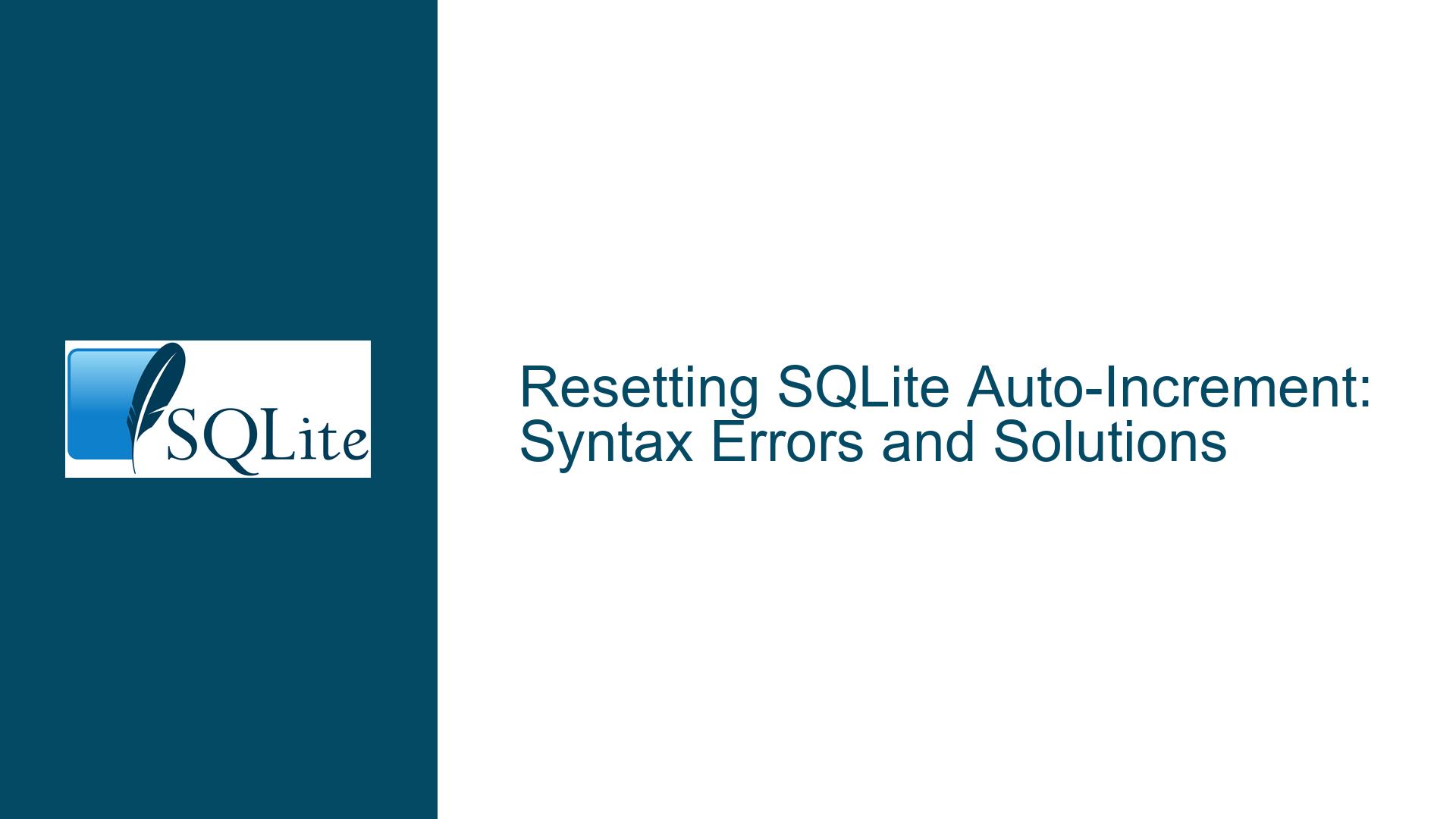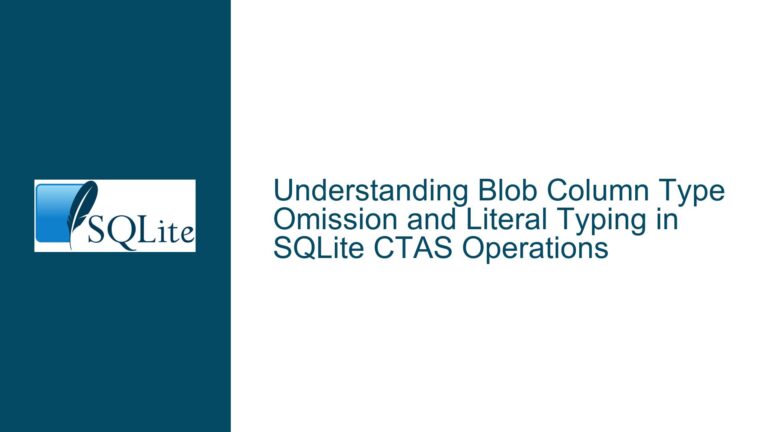Resetting SQLite Auto-Increment: Syntax Errors and Solutions
Attempting to Reset SQLite Auto-Increment with Incorrect Syntax
The original poster, Elfenliedtopfan5, encountered difficulties resetting the auto-increment value for a table named User in a SQLite database using DB Browser for SQLite. The initial attempts involved using ALTER TABLE statements, which resulted in syntax errors. Specifically, the following SQL commands were tried:
ALTER TABLE User AUTOINCREMENT = 1;
This command produced the error message: "near "AUTOINCREMENT": syntax error". This error indicates that SQLite does not support the AUTOINCREMENT keyword directly within the ALTER TABLE statement for resetting the sequence value. The AUTOINCREMENT keyword in SQLite has a specific meaning during table creation; it is not a general-purpose command for altering the current sequence value. The original poster assumed that the syntax would be similar to that used in other database management systems like phpMyAdmin with SQL databases, where such commands might be valid. However, SQLite handles auto-increment columns and sequence management differently.
The second attempt involved a combination of SET, UPDATE, and ALTER TABLE statements:
SET @num := 0;
UPDATE User SET UserID = @num := (@num+1);
ALTER TABLE User AUTOINCREMENT = 1;
This sequence of commands also failed, with the error message "near "SET": syntax error". SQLite does not support variable assignment using the SET command as seen in other SQL dialects like MySQL. The intention behind this approach was to renumber the existing UserID values and then reset the auto-increment counter. However, due to the syntax limitations and SQLite’s specific implementation, this method was unsuccessful. The combination of unsupported syntax and misunderstanding of how SQLite manages auto-increment values led to the initial errors. This highlights the importance of understanding the specific syntax and features supported by the particular database system being used.
The confusion stems from a few key areas. First, the syntax for modifying auto-increment values is not standardized across all SQL database systems. What works in MySQL or other systems may not apply directly to SQLite. Second, the AUTOINCREMENT keyword in SQLite has a distinct function during table creation, mainly to prevent reuse of deleted IDs, and it’s not intended for resetting sequence values. Finally, the absence of direct variable assignment in SQLite further complicates attempts to manipulate the sequence using procedural-style SQL code. The correct approach involves understanding the sqlite_sequence table and using the appropriate UPDATE statement, as will be discussed in the solution section. Understanding these nuances is critical for effectively managing auto-increment values in SQLite databases and avoiding common pitfalls.
Misunderstanding SQLite’s Auto-Increment Mechanism and Syntax Errors
Several factors contribute to the difficulty in resetting the auto-increment value in SQLite, as demonstrated by Elfenliedtopfan5’s initial attempts. These can be broadly categorized into misunderstandings of SQLite’s specific implementation of auto-increment, syntax errors arising from using commands incompatible with SQLite, and overlooking the role of the sqlite_sequence table.
Misunderstanding SQLite’s Auto-Increment Implementation: SQLite’s AUTOINCREMENT keyword, when used in a CREATE TABLE statement, has a very specific effect. It ensures that the automatically generated values for the primary key column never reuse values that have been used before, even if rows with those IDs have been deleted. This is different from many other database systems, where the auto-increment counter simply increments regardless of past values. The AUTOINCREMENT keyword imposes extra overhead and should only be used if preventing ID reuse is a critical requirement. Without the AUTOINCREMENT keyword, SQLite will recycle IDs from previously deleted rows. The key point here is that AUTOINCREMENT is a property defined at table creation, not a command to be used to reset or alter the sequence later on. The original poster’s attempt to use ALTER TABLE User AUTOINCREMENT = 1 reveals a misunderstanding of this fundamental aspect of SQLite’s design. The syntax suggests an attempt to set the auto-increment value directly, which is not how SQLite operates.
Syntax Errors and Incorrect SQL Commands: The use of ALTER TABLE User AUTOINCREMENT = 1 results in a syntax error because SQLite does not support this specific syntax for modifying the auto-increment value. The ALTER TABLE command in SQLite is used for modifying table schema, such as adding or dropping columns, renaming tables, and so forth, but it does not include a direct method for resetting the auto-increment sequence. Similarly, the attempt to use SET @num := 0 to initialize a variable fails because SQLite does not support variable assignment in this manner. SQLite is designed to be a lightweight, embedded database, and it lacks many of the advanced features found in larger database systems like MySQL or PostgreSQL, including user-defined variables. The combination of these syntax errors indicates a need to use SQLite-specific methods for achieving the desired outcome. These errors are symptomatic of attempting to apply SQL syntax from other database systems to SQLite without proper adaptation.
Overlooking the sqlite_sequence Table: SQLite uses a special table named sqlite_sequence to keep track of the auto-increment counters for tables that have an auto-increment column. This table is automatically created and maintained by SQLite. It has two columns: name, which stores the name of the table, and seq, which stores the current auto-increment value for that table. To reset the auto-increment value, one must directly update the seq column in the sqlite_sequence table for the relevant table. The original poster’s attempts did not involve querying or modifying the sqlite_sequence table, which is the correct way to reset the auto-increment counter. The failure to recognize and utilize this table is a significant factor in the initial difficulties encountered. Understanding the role and structure of the sqlite_sequence table is essential for managing auto-increment values in SQLite databases. The query SELECT * FROM sqlite_sequence; will reveal all of the current auto-increments.
Incorrectly Applying SQL Concepts from Other Systems: The user mentions familiarity with phpMyAdmin and SQL databases, which often use MySQL or similar systems. These systems have different syntax and methods for managing auto-increment values. For instance, MySQL supports ALTER TABLE table_name AUTO_INCREMENT = value to reset the auto-increment counter. Attempting to apply this knowledge directly to SQLite leads to syntax errors and incorrect assumptions about how auto-increment values are managed. The key takeaway is that each database system has its own specific SQL dialect and implementation details. A successful database developer must be aware of these differences and adapt their approach accordingly. The attempt to use a SET command for variable assignment, common in MySQL, is another example of applying concepts that do not translate to SQLite.
Lack of Specific SQLite Knowledge: SQLite is a unique database system with its own set of features, limitations, and best practices. A general understanding of SQL is not always sufficient for effectively working with SQLite. Specific knowledge of SQLite’s architecture, syntax, and system tables is required to perform tasks such as resetting auto-increment values. This knowledge can be acquired through the official SQLite documentation, tutorials, and practical experience. The original poster’s difficulties highlight the importance of investing time in learning the specific details of SQLite before attempting complex tasks. This includes understanding how SQLite handles data types, indexing, transactions, and other critical aspects of database management.
In summary, the difficulties encountered by the original poster stem from a combination of misunderstanding SQLite’s auto-increment implementation, using incorrect SQL syntax, overlooking the role of the sqlite_sequence table, incorrectly applying SQL concepts from other systems, and a general lack of specific SQLite knowledge. Addressing these issues requires a deeper understanding of SQLite’s architecture and syntax, as well as a willingness to consult the official documentation and learn from practical experience.
Correcting Syntax and Modifying sqlite_sequence to Reset Auto-Increment
To correctly reset the auto-increment value in SQLite, bypassing the syntax errors and addressing the core issue of sequence management, the following steps and solutions should be implemented. These steps involve directly interacting with the sqlite_sequence table, understanding the proper SQL syntax for SQLite, and considering the implications of resetting the auto-increment value.
Step 1: Understanding the sqlite_sequence Table: The sqlite_sequence table is a fundamental component of SQLite’s auto-increment mechanism. It stores the current sequence value for each table that has an auto-increment column. Before attempting to reset the auto-increment value, it’s crucial to understand the structure and contents of this table. Execute the following SQL query to view the sqlite_sequence table:
SELECT * FROM sqlite_sequence;
This query will display the table’s contents, showing the table names and their corresponding sequence values. The output will look something like this:
| name | seq |
|---|---|
| User | 10 |
| … | … |
The name column contains the name of the table with an auto-increment column, and the seq column contains the current maximum value used for that column. This table provides the necessary information for resetting the auto-increment value. If the table User does not appear in the sqlite_sequence table, it means that either the User table does not have an auto-increment column, or no rows have been inserted into it yet. In either case, inserting a row with a specified UserID will implicitly create an entry in sqlite_sequence.
Step 2: Correcting the SQL Syntax: The original attempts to use ALTER TABLE and SET commands resulted in syntax errors because SQLite does not support these commands in the way they were used. The correct approach is to use an UPDATE statement to modify the seq column in the sqlite_sequence table. The correct syntax is as follows:
UPDATE sqlite_sequence SET seq = 1 WHERE name = 'User';
This SQL command updates the seq column to 1 for the table named User in the sqlite_sequence table. The single quotes around User are crucial because, in SQLite, single quotes are used to denote string literals, while double quotes are used to denote identifiers (table and column names). If the table name is enclosed in double quotes, SQLite will interpret it as an identifier, and if a table with that exact name (including the quotes) does not exist, the query will fail. This distinction is important to remember when working with SQLite.
Step 3: Handling Cases Where sqlite_sequence Doesn’t Exist (or is Empty): In some cases, the sqlite_sequence table might not exist, especially in a newly created database or if no tables with auto-increment columns have been created yet. In other cases, the sqlite_sequence table might exist, but there might not be an entry for the User table if no rows have been inserted into it. Before running the UPDATE statement, it’s a good practice to check if the sqlite_sequence table exists and if it contains an entry for the User table. You can use the following SQL query to check if the sqlite_sequence table exists:
SELECT name FROM sqlite_master WHERE type = 'table' AND name = 'sqlite_sequence';
If this query returns an empty result set, it means the sqlite_sequence table does not exist. In this case, you should create a table with an auto-increment column first.
To check if there is an entry in the sqlite_sequence for the User table, you can use the following query:
SELECT seq FROM sqlite_sequence WHERE name = 'User';
If this query returns an empty result set, it means there is no entry for the User table in the sqlite_sequence table. In this case, you can insert a new row into the sqlite_sequence table:
INSERT INTO sqlite_sequence (name, seq) VALUES ('User', 0);
Then, you can proceed with the UPDATE statement to set the sequence value to 1.
Step 4: Verifying the Reset: After executing the UPDATE statement, it’s important to verify that the auto-increment value has been successfully reset. You can do this by inserting a new row into the User table and checking the value of the auto-increment column. For example:
INSERT INTO User (OtherColumn) VALUES ('SomeValue');
SELECT last_insert_rowid();
The last_insert_rowid() function returns the value of the last inserted row’s primary key. If the auto-increment value has been reset correctly, the value returned by last_insert_rowid() should be 1 (or the next available value if there were already rows in the table). If the User table is initially empty, the first INSERT should generate a UserID of 1. Subsequent inserts should increment from there.
Step 5: Handling Existing Data: Resetting the auto-increment value can have implications if the User table already contains data. If the UserID column is a primary key and you insert new rows after resetting the auto-increment value, you might encounter conflicts if the generated UserID values duplicate existing values. To avoid this, you can either renumber the existing UserID values or set the seq value in sqlite_sequence to a value higher than the maximum existing UserID. To renumber the existing UserID values, you can use the following SQL statements:
UPDATE User SET UserID = (SELECT COUNT(*) FROM User AS u WHERE u.UserID <= User.UserID);
UPDATE sqlite_sequence SET seq = (SELECT MAX(UserID) FROM User);
The first UPDATE statement renumbers the UserID values sequentially starting from 1. The second UPDATE statement sets the seq value in sqlite_sequence to the maximum UserID value in the User table. This ensures that new rows will have unique UserID values. However, renumbering the existing UserID values can have cascading effects if the UserID column is used as a foreign key in other tables. In this case, you would need to update the foreign key columns in those tables as well. Alternatively, you can set the seq value in sqlite_sequence to a value higher than the maximum existing UserID value. For example, if the maximum UserID value is 100, you can set the seq value to 101:
UPDATE sqlite_sequence SET seq = 101 WHERE name = 'User';
This ensures that new rows will have UserID values greater than 100, avoiding conflicts with existing data. Choose the method that best suits your specific needs and data constraints.
Step 6: Using AUTOINCREMENT Keyword Judiciously: As mentioned earlier, the AUTOINCREMENT keyword in SQLite has a specific effect: it prevents the reuse of previously used UserID values, even if the corresponding rows have been deleted. This comes with a performance overhead, as SQLite needs to maintain an internal index of used UserID values. If you don’t need this behavior, you should avoid using the AUTOINCREMENT keyword. If you do need this behavior, make sure to include the AUTOINCREMENT keyword in the CREATE TABLE statement when creating the User table:
CREATE TABLE User (
UserID INTEGER PRIMARY KEY AUTOINCREMENT,
OtherColumn TEXT
);
If you add the AUTOINCREMENT keyword later using ALTER TABLE, it will not have the desired effect. The AUTOINCREMENT keyword must be present in the CREATE TABLE statement for it to work correctly. Using the AUTOINCREMENT keyword judiciously can improve the performance of your SQLite database and avoid unnecessary overhead. Only use it if you specifically need to prevent the reuse of previously used UserID values.
Step 7: Error Handling and Transactions: When performing database operations, especially those that modify data, it’s important to handle errors and use transactions to ensure data consistency. If an error occurs during the UPDATE or INSERT statements, the database might be left in an inconsistent state. To prevent this, you can wrap the statements in a transaction. A transaction is a sequence of operations that are treated as a single unit. If all operations succeed, the transaction is committed, and the changes are saved to the database. If any operation fails, the transaction is rolled back, and the database is restored to its original state. Here’s an example of how to use transactions in SQLite:
BEGIN TRANSACTION;
UPDATE sqlite_sequence SET seq = 1 WHERE name = 'User';
INSERT INTO User (OtherColumn) VALUES ('SomeValue');
COMMIT;
If any of these statements fail, the entire transaction will be rolled back, and the database will remain unchanged. You can also use the ROLLBACK statement to explicitly roll back a transaction if you encounter an error:
BEGIN TRANSACTION;
UPDATE sqlite_sequence SET seq = 1 WHERE name = 'User';
INSERT INTO User (OtherColumn) VALUES ('SomeValue');
-- If an error occurs, roll back the transaction
ROLLBACK;
Using transactions ensures that your database remains in a consistent state, even if errors occur during data modification. Always use transactions when performing multiple related database operations.
By following these steps, you can effectively reset the auto-increment value in SQLite, correct the syntax errors, and ensure data consistency. These solutions address the core issue of sequence management and provide a comprehensive guide for handling auto-increment values in SQLite databases. Remember to adapt these steps to your specific needs and data constraints, and always use transactions to ensure data integrity.






